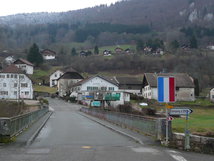Border: France-Switzerland
Overview
Levels of governance
At border level
At the level of the French-Swiss border, the involvement of the states is essential, particularly on issues of competitiveness, taxation, health (local health contracts, involvement of regional health agencies), transport infrastructure funding (Belfort-Delle link), employment, environment (cooperation between Doubs DDT (departmental territorial directorate) and the Swiss water quality service on the management of the river Doubs). Three bodies provide a framework for relations between the States at border level: the Franco-Germano-Swiss Intergovernmental Commission (IGC), the Joint Consultative Commission1 (1973) and the French-Swiss dialogue on cross-border cooperation (2005).
The Franco-Germano-Swiss IGC aims to facilitate the study and the solution of problems between neighbouring border areas in all the regions making up the Upper Rhine, i.e. at the level of the three countries. Its main function is dialogue at inter-state level.
The role of the Joint Consultative Committee is more specific: it deals with questions linked with financial compensation and territorial development in relation to the Geneva cross-border conurbation.
The French-Swiss dialogue on cross-border cooperation brings together ministry representatives, deconcentrated services of the state and regional authorities, and discusses various cross-border topics with a view to sharing of good practices.
At regional level
Within this heterogeneous territory, a number of regional-level cooperation bodies have been established, for example in the Basel area of the Upper Rhine (Upper Rhine Conference, Upper Rhine Council, Tripartite Congresses).
Cooperation on the Geneva cross-border conurbation (encompassing the municipalities in Ain, Vaud, Valais and Geneva) is organised by a France-Geneva Regional Committee (Comité régional franco-genevois – CRFG), which has a role in the definition of strategies on the cross-border programmes and projects undertaken within the framework of the Greater Geneva LCCG.
On the Jura part of the border, the Trans-Jura Conference (CTJ) organises the cooperation. Formerly the Communauté de travail du Jura, established in 1985 and covering the Jura arc, its purpose is to develop exchanges and improve communication and cooperation between the political and administrative institutions on either side of the border.
At department and local level
At the level of the departments, cantons and cities, there is a real momentum at work in the urban areas and the rural territories, with the establishment of several cooperation organisations, in the form of a Eurodistrict for the Basel conurbation in 2007 (Basel Trinational Eurodistrict), or in the form of an LCCG in Greater Geneva and an EGTC in the Espace Mont Blanc, a mountainous territory covering parts of Savoie, Haute Savoie, Aosta Valley (Italy) and Valais (Switzerland).
The development of the France-Vaud-Geneva conurbation project has seen the growing involvement of inter-municipal organisations in cross-border cooperation. They first came together in the Association régionale de coopération du genevois (ARC), which became a joint association in 2010 and which will eventually be transformed into a metropolitan area.
Other examples of this cross-border impetus that should be mentioned are the Agglomération urbaine du Doubs (consisting of the municipalities of La Chaux-de-Fonds, Le Locle, Les Brenets, Morteau, Villers-le-Lac and Les Fins, it deals with issues relating to this cross-border conurbation) and the Parc Naturel Régional Transfrontalier du Doubs project.
Lastly, a metropolitan area covering the Alpine corridor (Valence, Voiron, Grenoble, Chambéry, Annecy and Annemasse) is planned. One of its priorities would be to encourage the development of cross-border cooperation mechanisms at this level with Geneva (via Annemasse and the Geneva cross-border conurbation) and northern Italy (e.g. the Lyon-Turin project).
State-level body to which the France-Geneva Regional Committee (CRFG) is accountable.
Key dates in the history of the CRFG [French only]


